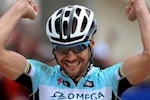The Hell of the North live on France Télévisions
 After the Paris-Nice, the Critérium International and the Tour of Flanders, France 3 television continued its coverage of the 2012 cycling season with the 110th edition of the Paris-Roubaix race, dubbed variously The Queen of the Classics and The Hell of the North.
After the Paris-Nice, the Critérium International and the Tour of Flanders, France 3 television continued its coverage of the 2012 cycling season with the 110th edition of the Paris-Roubaix race, dubbed variously The Queen of the Classics and The Hell of the North.
The Paris-Roubaix race is an unusual and arduous race and thus both sought-after and dreaded. 25 teams start in Compiègne and cover some 258 kilometers (160 miles) of the designated route. The highlight of the race is most certainly the legendary cobblestone section of the Trouée d’Arenberg. Last year, Johan Vansummeren, a Belgian (of course) won the race. This year, Tom Boonen (another Belgian) won it for the fourth time following a heroic 53k solo breakaway.
Jean-Maurice Ooghe, for whom cycling events hold no secrets, was at the helm of the television broadcast. He is the producer of the Tour de France and all other major cycling events in France, and this was his 14th “participation” in the Paris-Roubaix race.
“I am originally from the North of France and I remember as a child we went to watch this incredible race along its course,” he explains.
Unlike the filming of the Tour de France stages, shots of the Paris-Roubaix focus mainly on the race and in particular on the rider’s considerable efforts. There is a lot less footage devoted to the sidelines i.e. the scenery and landmarks such as monuments along the route (which represents about a third of the airtime of the “grande boucle”). Nevertheless huge technical means are employed.
Four motorcycles are used (as opposed to three for the Paris-Nice race) with another two for two journalists and the sound-recording equipment.
“Due to the cobblestones, we have to use trail bikes, which are very different to the ones we normally use. Also, to showcase the vibrations generated by the bike and the chains in particular, I sometimes ask my cameramen to place the camera very low. It’s very physically demanding,” explains the producer.
When filming a mountain stage, it is very difficult for the motorbikes to overtake and catch up with breakaway riders for example, so a fifth motorbike is positioned on standby, ahead of the race and prepared for all contingencies.
Aerial coverage is provided by two helicopter teams who work in relay (to extend the flight range). After the cobblestone section of Arenberg and a few kilometers from the finish line, the two helicopters fly in unison. On board, shooting with a very powerful zoom is of utmost importance in order to show the difficulty of the race. Throughout the race a wide-angle camera is also used to provide panoramic views.
Euromédia handles the RF systems whereas Globecast is in charge of the satellite broadcast. In order to do so, two additional helicopters and an airplane fly continuously over the route
There are 9 static cameras located inside the Roubaix velodrome where the last 750 meters of the race takes place and the podium is situated.
